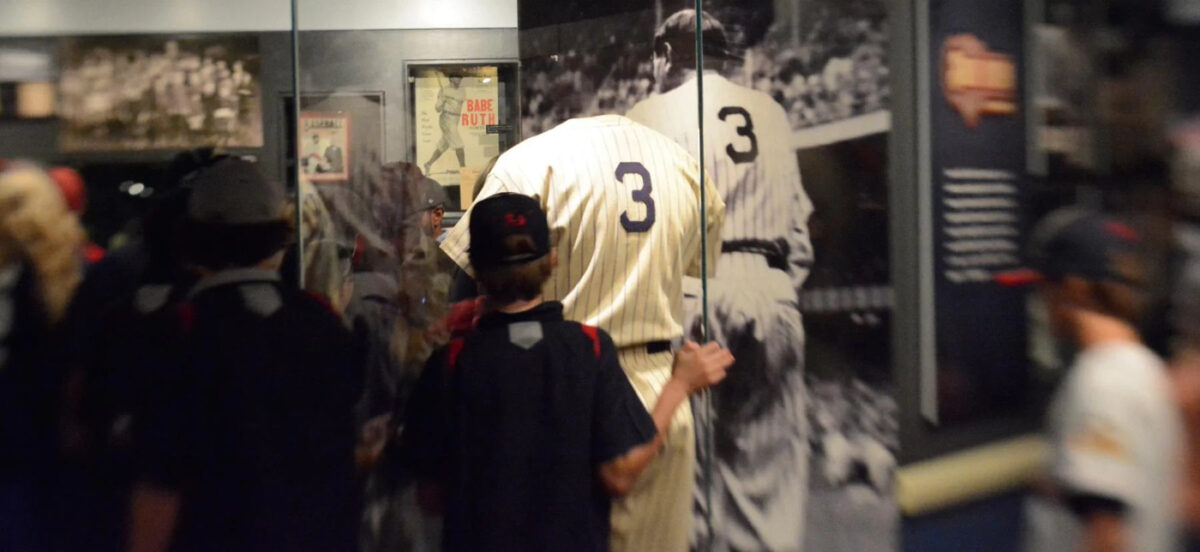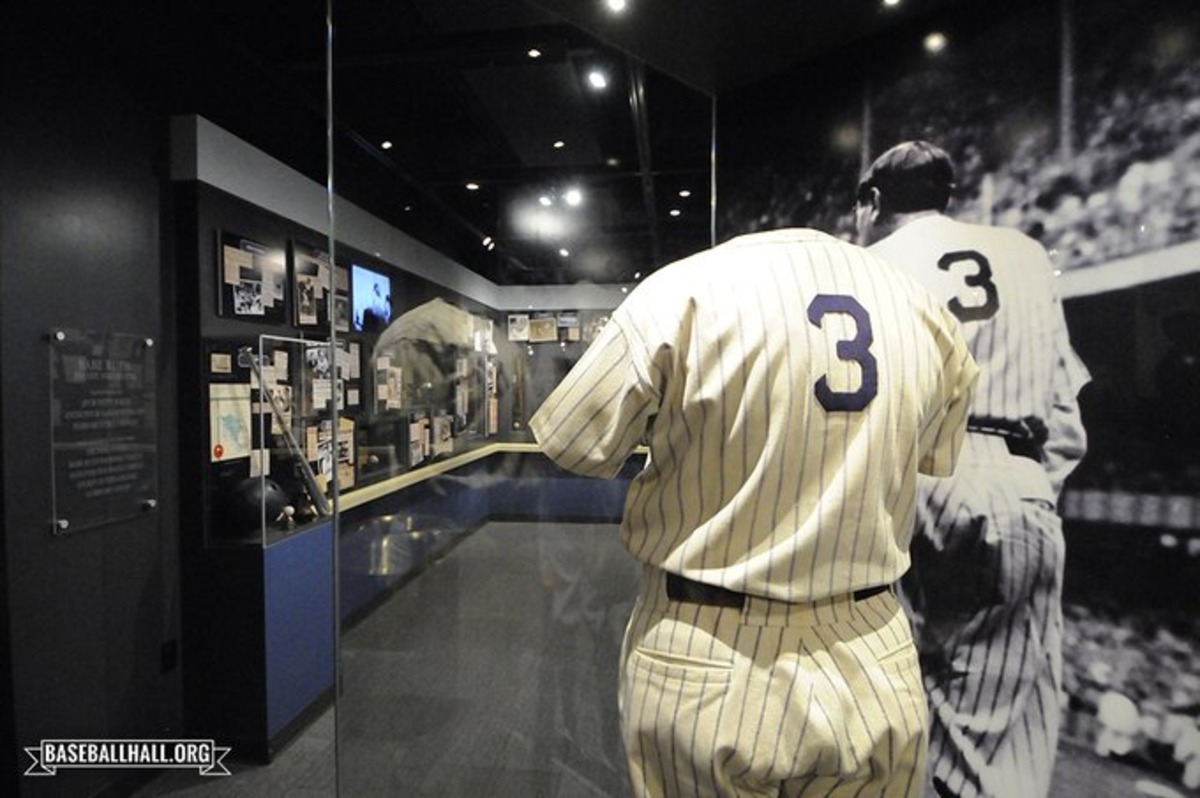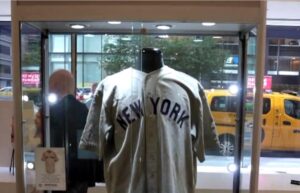The most unique Babe Ruth jersey: Never worn in a game yet in the Hall of Fame

Joe Najarian
More Stories By Joe Najarian
- Mother’s Day: How Anthony Volpe’s mom molded him into a Yankee phenom
- Boone confirms Anthony Rizzo’s likely Sunday activation for Yankees
- Yankees 5-6 Cardinals: Stanton’s near Grand Slam falls short as St. Louis earn first-ever win at new Yankee Stadium
- Wait by ex-Yankees player for Topps Card face change nears five decades
- Yankees injury latest on return of Rizzo, Gil, Schmidt, Berti
- May 27, 2024
- 11:24 am
- No Comments
Table of Contents
The National Baseball Hall of Fame and Museum’s exhibit “Babe Ruth: His Life and Legend” celebrates the singular journey of Babe Ruth, a player who transcended the game to become an integral part of American culture. The exhibit brings the Yankees legend’s larger-than-life persona to life through the eyes of those who witnessed it firsthand.
Among the more than 50 three-dimensional artifacts featured in the exhibit, none is more evocative than the woolen No. 3 jersey acquired by the Hall of Fame on June 13, 1948, the day the Yankees officially retired Babe Ruth’s number. According to Tom Shieber, the Museum’s senior curator and lead curator of the Babe Ruth exhibit, a Hall of Fame official was present at Yankee Stadium when the legend handed over the uniform.
The iconic photograph of Babe Ruth gazing out at the field, the number “3” emblazoned on his back, was captured by Pulitzer Prize-winning photographer Nat Fein and seen by audiences worldwide. Shieber emphasized the incredible significance of the Hall of Fame possessing this jersey, hinting at the deeper stories woven into the fabric of the exhibit.

The unique story of Babe Ruth’s jersey
Through a collection of artifacts and personal accounts, “Babe Ruth: His Life and Legend” offers visitors a glimpse into the life and legacy of a man who became synonymous with the sport of baseball and left an indelible mark on American culture.
The story of Babe Ruth’s iconic No. 3 jersey, now on display at the National Baseball Hall of Fame and Museum, began in the summer of 2012 when Thomas Tull, a member of the Hall of Fame’s Board of Directors, loaned a game-worn Babe Ruth jersey from 1920 to the Museum. The jersey was promptly placed in the sports immortal’s locker, replacing the “retired number” jersey previously exhibited.
According to Tom Shieber, the Museum’s senior curator, this change provided an opportunity to reexamine the “retired number” jersey, which had not been thoroughly studied for many years. With the help of newly available research resources, including digitized newspapers and recently discovered photographs, the curatorial team made a stunning discovery.
Following the June 13, 1948 ceremony at Yankee Stadium, where Babe Ruth’s number was officially retired, the baseball legend immediately donated his cap, shirt, pants, belt, and socks to the Museum, personally handing them to Hall of Fame representative Bob Quinn. These items were put on display in Cooperstown just nine days later.
However, Babe Ruth didn’t inform Quinn that he had worn the jersey and pants at numerous benefit games and appearances throughout the 1940s. These events included an Aug. 26, 1943 game at the Polo Grounds that raised $800 million in war bonds and a July 12, 1943 event at Fenway Park where he met Ted Williams. The newfound historical context surrounding the “retired number” jersey adds a deeper layer of significance to this remarkable artifact, further cementing its place in baseball history.

Babe Ruth’s iconic jersey in movie
The journey of Babe Ruth’s iconic jersey, now housed at the National Baseball Hall of Fame and Museum, has been meticulously traced by matching historical photographs to the pinstriped uniform. The Yankee pinstripes provided unmistakable lines that allowed the jersey’s path to be easily followed, but the most significant clue came from Babe Ruth’s silver screen performance in the 1942 Samuel Goldwyn picture “The Pride of the Yankees.”
In the film, Babe Ruth played himself and was provided a uniform by the Western Costume Company, as were the other actors. Two scenes in the movie featured him wearing a pinstriped home Yankees jersey, and the stripes matched perfectly with the jersey the Hall of Fame acquired from Ruth on June 13, 1948.
According to Tom Shieber, the Museum’s senior curator, the movie producers strived for historical accuracy. Babe Ruth’s first appearance in a Yankees uniform was set in 1923 when the team wore plain, pinstriped jerseys, which the filmmakers accurately depicted. However, a later scene, intended to take place in 1933, showed Babe Ruth and his teammates wearing uniform numbers on their jerseys, which was correct, but also featuring the iconic interlocking “NY” on their shirt fronts, which was inaccurate. During the legend’s tenure with the Yankees, the club never wore the interlocking “NY” design on their jerseys.
These inconsistencies inadvertently helped solve a mystery. The misplaced “NY” on Babe Ruth’s jersey appeared in the movie and publicity stills at two slightly different locations relative to the pinstripes, as movie scenes are not shot in chronological order. Shieber explained that the stitches on the “3” and “NY” were loose, allowing the studio tailor to easily remove and reattach them for different shots. When the “NY” was replaced for the final scenes, it was positioned at a marginally different location on the front of Babe Ruth’s jersey.
The meticulous examination of historical photographs and the clues provided by Babe Ruth’s performance in “The Pride of the Yankees” have shed new light on the remarkable journey of this iconic piece of baseball history.
The pants worn by Babe Ruth on June 13, 1948, when his number was retired by the Yankees, were not the same pants he wore in “The Pride of the Yankees” or any of his known appearances with the “retired number jersey” throughout the 1940s. However, many of those appearances featured Ruth wearing pants that match another pair in the National Baseball Hall of Fame and Museum’s collection, which were donated following his death in 1948.
According to Tom Shieber, the Museum’s senior curator, the change in pants was likely due to Babe Ruth’s weight loss in the spring of 1948, as he battled cancer. The pants from “The Pride of the Yankees” had become too large for him, and the pants he wore on June 13, 1948, had a smaller waistline, suggesting they dated back to his earlier playing days.

Shieber emphasized that unraveling such mysteries is a labor of love for the Museum’s history detectives, who believe that the magic of baseball lies in its history – stories that preserve the details of the game and the moments that make up the American experience. He noted that a jersey like the one Babe Ruth donated on June 13, 1948, is more than just a shirt; it is a personal artifact of a man who remains larger than life, even more than 60 years after his death.
The discovery of the true origins of Babe Ruth’s “retired number jersey” and pants adds another layer to the rich tapestry of baseball history, further solidifying the Bambino’s enduring legacy.
What do you think? Leave your comment below.
- Categories: Babe Ruth, Yankee Legends, yankees jersey
- Tags: Babe Ruth, Yankee Legends, yankees jersey


 Follow Us
Follow Us









